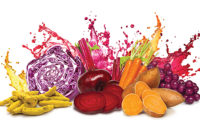Coloring Options

A food’s “look” is important and products that fail to make a good first impression are likely to stay on store shelves. Before Sir William Perkin discovered the first synthetic dye in 1856, natural colors from herbs, fruits and spices were used to enhance food appearance
Colors derived from “natural sources” are not exempt from regulation, even though they are natural constituents of foods. In both Europe and the U.S., colors derived from “natural sources” are still subject to existing regulations for color additives. The government agencies responsible for regulating color additives in Europe (EFSA) and the U.S. (FDA) both allow the use of a number of substances to impart color. The agencies sometimes differ on use restrictions, which color additives or concentrations of color additives are permitted or require different labeling or standards for the additives. Food manufacturers should keep abreast of regulatory actions by both agencies if they want to sell the same product in multiple markets, without reformulating.
Are All Colors “Color Additives”?
In the U.S., all ingredients deliberately added to food to provide color are considered “color additives,” even if they are derived from natural sources (21CFR§70.3(f) and 201(t)(1) of the Federal Food, Drug and Cosmetic Act (FDCA)). Under Title 21 of the U.S. Code of Federal Regulations (21 CFR)§70.3(g), a material that otherwise meets the definition of color additive can be exempt from that definition on the basis that it is used (or intended to be used) solely for purposes other than as a coloring, as long as the material is used in a way that any color imparted is clearly unimportant insofar as the appearance, value, marketability or consumer acceptability is concerned. Based on these definitions, a substance such as naturally-derived lycopene would be categorized as a color additive if it was added to a food that was not originally red and the lycopene imparted a red color. However, if the lycopene was added for another reason (such as an antioxidant) to a food, such as ketchup, at a level that did not alter the color of ketchup, it would not be regulated as a color additive.
In the U.S., the only color additives that can be legally used in food must be approved for food use via a color additive petition. Color additives that have been approved only for drug or cosmetic use (i.e., D&C colors) cannot be added to food. Currently approved color additives for food, as well as their requirements and limitations, are listed in the Code of Federal Regulations (CFR) Sections 21CFR§73 or 21CFR§74. (See “Website Resources” for the complete website address or type http://tinyurl.com/23tt3t9 into the browser.)
Color additives subject to batch certification include synthetic organic dyes, lakes or pigments, such as the Food, Drug and Cosmetic (FD&C) colors, and are known as “certified colors.” Batch certification is required when the composition needs to be strictly controlled to ensure safety. Batch certification includes the process of taking a sample from each batch of a newly manufactured color and submitting it to the FDA for testing to determine whether it meets the color additive’s requirements for composition and purity. If it does, the FDA “certifies” the batch and issues a certification lot number. Only then can that batch be used legally in FDA-regulated products
Color additives exempt from certification include, but are not limited to, naturally-derived colors, such as beta carotene (21CFR§73.95), tomato lycopene extract or concentrate (21CFR§73.585), annatto extract (21CFR§73.30), dehydrated beets (21CFR§73.40) and turmeric (21CFR§73.600). Exemption from certification does not mean a color additive is exempt from requiring a color additive petition, only that the certification process is not required. Although color additives mentioned in Section 21CFR§73 are not subject to batch certification requirements, they must comply with their specific regulation, which may be very restrictive regarding source, identity, solvent used for extraction, solvent residue, permitted diluents, heavy metal content, labeling and uses and restrictions. Additional requirements may also apply (e.g., a required method of analysis). Regardless of whether a color additive is subject to or exempt from certification, it is subject to strict regulations for identity and use.
Proper Labeling is Essential
The Nutritional Labeling and Education Act of 1990 (NLEA) and regulations emanating therefrom, require that food labels contain the names of any color additives subject to certification (21CFR§101.22(k)
The FDA is vigilant about use and declaration of approved colors in the U.S., and not all colors can be used in all foods. Some FDA regulations only allow certain colors to be used in certain foods. A recent FDA import alert
For example, FD&C Yellow #5 has been suspected as the cause of some allergic reactions, including asthma and urticaria (hives). Additional food products have been detained due to detection of unknown colors, undeclared colors that are exempt from certification (e.g., sodium copper chlorophyllin) or unpermitted colors from natural sources that are permitted in other countries (such as safflower extract)4. FDA personnel also scrutinize ingredient labels for mislabeled color additives identified with their European name (or E number designation), color index number, INS number, or trade or common name (e.g., tartrazine), telltale signs that the color additives may not be approved for use in the U.S.
Existing Color Regulations are Changing
Food manufacturers must keep current on color additive regulations because certain regulations have been revised in the U.S. and Europe, and more changes may be on the horizon. An example is the regulation for cochineal extract and carmine (21CFR§73.100), two color additives derived from cochineal beetles. Currently, these color additives may be declared on labels as “artificial color” or “color added.” In response to reports of severe allergic reactions, including anaphylaxis, to foods containing cochineal extract or carmine, the FDA issued a final rule on January 5, 2009 (74 FR207), amending the regulations for these color additives. Effective January 5, 2011, labels of all foods containing cochineal extract or carmine must refer to these substances by name, to allow consumers who are allergic to these color additives to avoid their consumption. It is expected this labeling requirement will lead to decreased usage of cochineal extract and carmine as food colorants.
As part of the review of the safe use of a color additive, the petitioner must indicate the Acceptable Daily Intake (ADI) of the additive, defined as an estimate of the amount of a food additive that can be ingested daily over a lifetime, without appreciable health risk. EFSA recently reduced the ADIs for Quinoline Yellow (E104), Sunset Yellow FCF and Ponceau 4R
Future Outlook for New Colors
The new regulations in the U.S. and Europe will likely diminish usage of some synthetic colors previously employed to color food yellow, orange and red. It is probable there will be a corresponding increase in the use of natural source color additives to impart these hues. New colors should not be derived from known allergenic sources like milk, egg, fish, crustacean shellfish, tree nuts, wheat, peanuts, soybeans or cochineal beetles, or a warning label will be required.
Several naturally-derived color additives that can be used to color food yellow, orange or red (such as ß-carotene, turmeric or lycopene) are also generally recognized as safe (GRAS) in food for other purposes. As inferred from the color additive regulations, other food ingredients that have received GRAS (or food additive) status could potentially be considered color additives, when used to impart color. As such, a color additive petition must be filed for any GRAS substance (or food additive) that fits the definition of a color additive (i.e., if it will be used as an intentional color additive when used at higher concentrations and/or in additional foods than those stated in the original GRAS determination or food additive petition). Fruit extracts or powders that are GRAS for flavorings may be considered color additives, under either one of these scenarios.
As natural source color additives replace synthetic colors, their usage may increase to the point where the additives are consumed at levels above currently demonstrated safe levels. This fact is not going unnoticed by regulatory agencies. In January, 2010, EFSA announced it was reviewing the maximum allowable levels of lycopene in a number of food categories, because the increasing use of lycopene in foods could increase consumption over the currently recommended ADI
What Should Be Done?
Food manufacturers have a lot to consider these days, as the regulation of synthetic and natural source food colors undergoes review and modification in the U.S. and Europe. Existing regulations vary across borders. Wise manufacturers will consult the rules of all the countries they seek to market to, in order to avoid unnecessary reformulation. In response to new regulations, it is expected that there will be an increased demand for natural sources of yellow, orange and red food colors. Developers can use currently approved colors from natural sources to fill this void. However, because the use of existing natural source colors may increase to levels that are not known to be safe, colors from new sources should be developed and approved for use in food. In the U.S., substances that have been determined GRAS for another purpose could be used as colors, but only after a color additive petition has been approved. The fact that all colors, regardless of source, must be properly declared on labels and that the term “natural color” is not recognized by the FDA should be forefront in the minds of food manufacturers when they are developing new products for market in the U.S. Something as seemingly innocuous as color may make the product a success or a failure. pf
Website Resources:
www.PreparedFoods.com – Type “colors” into the search field
www.fda.gov/ForIndustry/ColorAdditives/ColorAdditiveInventories/ucm115641.htm#table1A -- CFR info on color additives in food
References:
1 Henry, BS. (1996). Natural Food Colors (Chapter 2). In Natural Food Colorants (Hendry GAF and Houghton JD, Eds.). Blackie, Academic & Professional, London, England.
2 www.fda.gov/ForConsumers/ConsumerUpdates/ucm048951.htm or http://tinyurl.com/2g3mjph (Accessed 5/17/2010).
3 www.accessdata.fda.gov/cms_ia/importalert_118.html or http://tinyurl.com/282lej6. Note: Site may be very slow to load.
4 www.fda.gov/downloads/Food/GuidanceComplianceRegulatoryInformation/ComplianceEnforcement/ucm073305.pdf or http://tinyurl.com/2856asd (Accessed 5/17/2010).
5 www.efsa.europa.eu/en/press/news/ans091112.htm or http://tinyurl.com/2fk8h9y (Accessed 5/17/2010).
6 McCann D, et al. 2007. Lancet. 370:1560–1567.
7 http://eur-lex.europa.eu/LexUriServ/LexUriServ.do?uri=OJ:L:2008:354:0016:0033:en:PDF {Annex V} or http://tinyurl.com/25a6hp7.
8 www.efsa.europa.eu/en/efsajournal/doc/1444.pdf or http://tinyurl.com/26vond5 (Accessed 5/17/2010).
Looking for a reprint of this article?
From high-res PDFs to custom plaques, order your copy today!





